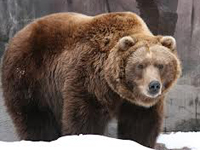

 |

|
 Grizzly Bear |
Grizzly Bear(Mammal) |
 Grizzly Bear Baby |
Grizzly Bear HabitsIn its natural home the grizzly bear has no enemies or predators. It is not especially territorial and it will tolerate other grizzlies. The grizzly rarely fights, but when it does, it usually wins. Most fights occur during the mating season or when a sow must defend her cubs from attack.
The Grizzly bear is often seen as the most fearsome of the carnivores whom Man can encounter. However, the bears are usually shy and stay well clear of humans. The exceptions can be startling a bear on a trail, or coming across a bear when she is with cubs. Such encounters can often be avoided by using bear bells. If you are attacked, authorities suggest climbing a tree, as grizzlies (unlike black bears) will not climb. If there are no trees to be had, then back off as quickly as possible, drop something to distract the bear, and in the worst of all scenarios, play dead. |
Grizzly Bear CommunicationGrizzly bears have a complex system of communication that makes use of vocalization, body language and chemical odor cues.
Grizzly bears rarely make true vocalizations, normally relying on non-voiced sounds. Generally females will moan, grunt or growl as a means of communicating with her young. Males may make similar vocalizations, in addition to bellowing, during mating season and combats with other males. Non-voiced sounds may include snorting, huffing, clacking teeth, popping the jaw or blowing air out of the nostrils -- all to indicate agitation, aggression or fear depending on the context of the situation.
Body language including posture and movement are key components to grizzly bear communication. How a bear is standing, moving or behaving can provide clear indicators of the bears intentions to both other bears and humans. A grizzly who is walking away, sitting or lying down is demonstrating subordination and an unwillingness to fight. Similarly, a bear who yawns, looks away and remains motionless is indicating that he wants to be left alone. Aggression in grizzly bears is often demonstrated by lunging with ears flattened against the head, slapping the ground, lowering or swaying the head, or charging. A bear who stands on his hind legs is not necessarily attempting to convey aggression, but is more likely simply attempting to get a better look at his environment.
Male grizzlies use scent communication in the form of tree rubbings -- wherein they rub their backs, heads or chests against a tree to mark it with their scent to alert other males to their presence and reduce confrontation. By marking a tree with his individual scent, a male grizzly is letting others know that he is in the area. A smaller male who approaches an area with trees marked by a larger male may choose to leave the territory rather than risk a fight.
Grizzly bears may occasionally communicate through visual methods as well, clawing or chewing on trees to alert other bears of their presence. This is a similar activity to the tree markings intended to leave behind scent, and may be used for a similar purpose. |
Grizzly Bear Breeding Male grizzlies attract mates by making low snorts and nibbling the females' backs and necks. Although mating occurs in June, the fertilized eggs are not implanted into the womb until fall. This gives the pregnant sow time to store food.
Gestation takes 180 to 150 days, and birth occurs in the den during winter. The newborn cubs are blind, toothless, and almost hairless. They are 8 inches long and weigh between 1 - 1.5 lbs. The cubs remain in the den with their mother until spring, feeding on her rich milk. In April or May the mother takes the cubs out and teaches them to forage and hunt. They stay with her during the first winter after birth. |
Grizzly Bear Food & FeedingThe grizzly is an omnivore, which means it is equally satisfied by both vegetable and animal matter. Its diet includes fruits, berries, nuts, roots, fish, rodents, and occasionally other mammals. It even eats carrion (dead flesh), which it can smell from as far as 18 miles away. The grizzly's teeth have become modified over the centuries to suit its varied diet. When a grizzly kills a large animal such as a caribou, it chooses one that is young, weakened or wounded. The kill can last a sow and her cubs for 4 to 5 days. The mother hides the carcass from other animals between feeding times. Grizzlies may also dig out smaller prey, such as ground squirrels, with their long, sharp claws. |
Grizzly Bear Key Facts |
| Size |
| Height: Standing Height: Average 6 ft |
| Weight: Varies from 200-650 lb. according to location |
| Breeding |
| Sexual maturity: Males, 4 years. Females, 3 years |
| Mating: June |
| Gestation: 180-250 days |
| Number of young: Usually 2 |
| Lifestyle |
| Habit: Solitary, except during breeding season |
| Diet: Variety of fruit, berries, tubers, insects, grubs, honey, fish, rodents |
| Lifespan: Maximum 30 years |
DID YOU KNOW?
|
CAN'T FIND WHAT YOU'RE LOOKING FOR? CLICK HERE!!!